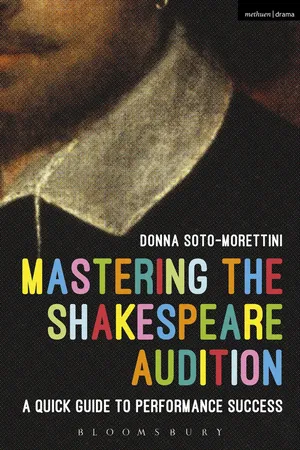![]()
PHASE 1
ACQUIRING THE SKILLS
Adding vocal colour
Imagine seeing many art exhibitions in a row, all of them in black, white and grey. Imagine that wherever you went – from national galleries to fine art supply stores – you could only find black, white and grey. If you truly could imagine that, then you can probably roughly imagine what I go through when I serve as an audition panellist. I’m not talking here about what I see, but about what I hear. Because what I hear is mostly a very limited ‘black-white-grey’ palette of sound. Occasionally, I get a glimpse of something colourful, but rarely do I see the full spectrum of colour, weight, texture or sustained effort that one might desire in a work of art.
Before all else, we are going to look at one of the most important tools you can acquire: enhanced vocal expression. Of course, most training conservatoires spend many hours a week over two or three years to train actors’ voices and we can’t do that here. It is important to note that we are going to be working with the voice you have. We won’t be able to go into things like resonance, placement, dialect, or even overall quality of sound. Your voice may or may not need that kind of work, but whatever point you are at in terms of training or speech quality, all we can do here is work on extending and enhancing the sound you have now in the service of expressing heightened language.
It is hard to explore new vocal possibilities if we bring our usual habits to a text. One of the things we bring is our desire to make sense (logical or emotional sense) of things as we read. If we explore in a kind of detached way, however, we tend not to worry about whether a sound ‘matches’ meaning, or whether a sound is the logical way to express a particular idea, or even whether we are comfortable with a sound. This is why it is so important to keep our early explorations here detached from any sense, emotion or meaning that we generate.
This doesn’t mean that we won’t allow what we hear or feel as a result of making sound to resonate with us somehow. But the important word in that sentence is the verb: ALLOW. Allow sound to affect you, but don’t generate any meaning of your own while we do our technical work, just listen to the sound as you are making it and let it resonate with you. Enjoy the feeling of making big or unusual sounds. Subconscious responses can sometimes be valuable – let whatever comes through just come through! In the exercises that follow, we are going to find out if we can work from the ‘outside-in’, to push our sound palette into new areas.
Doing vocal exercises out of a book can be very difficult. I’ve tried to make these as simple as possible and if you do them with a speech analyzer, you should be able to see immediately if you are getting results.
Diction
Most actors understand the idea of good diction, which I’m going to refer to here as an important part of true clarity in spoken language. Of course, diction isn’t the only ingredient in clear language – a slightly slower speech rate, enhanced vowel duration, expanded pitch range and greater sound pressure levels are all part of the adjustments speakers make when they’re attempting to be as clear as they can be. Diction is often about creating a marked distinction in consonant sounds. We are going to concentrate on the consonants first.
Often actors find that the effort needed to produce strong, distinct consonant sounds feels rather ‘fake’ to them. There’s only one way to get over this: familiarity. You need to get so used to expending more effort in your diction that it DOESN’T feel fake. If 90 per cent of your acting expression is carried through the medium of soft/slightly slurred consonants, whispery moments of intensity and a ‘normal’ speaking range, then suddenly acquiring sharp, clear consonants and as wide a vocal range as possible is going to be difficult to marry up with what you perceive to be your ‘truthful’ acting intentions. However, we are not going to worry about that now, because to start with, we are not going to be acting!
In Phases 1 and 2, we are going to be working in the same way that ballet dancers work at a barre or the way that piano players work on scales: that is to say, you will never see this work on stage in performance, but barre exercises and piano scales are the building blocks of great performance for both artists. Great diction, resonant and clear sound and impressive vocal range are some of the key building blocks for a great performance wh...
